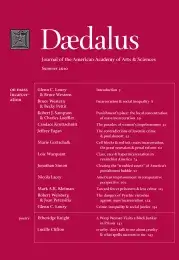The paradox of women’s imprisonment
It’s very hard. . . . It is very hard. There are eight women in one room, you know . . . especially when everybody gets up in the morning and gets ready at the same time. . . . There was six to a cell; now they put another [bunk] bed in there, which made it eight. It’s terrible.
I think sometimes . . . we’re like, we’re getting warehoused, through storage, you know . . . women’s storage or something . . . just kind of put away, because um, you don’t see much focus on women’s prison. You see a lot on men’s.
–From inmates at Valley State Prison for Women1
In 1991, during the height of the imprisonment boom in the United States, a distinguished scholar commenting on a Blue Ribbon Commission on Inmate Population Management noted that because females represent only a fraction of the prison population they are relatively unimportant. As he put it, “[W]hen you have got as much of a change as we do in a system, which is 95 percent male . . . you are not going to be looking hard at the females in the system.”2 On one level, this assertion makes perfect sense given the small percentage females occupy in the overall prison population. On another level, the increasing rate of imprisonment of female offenders may produce a wide range of unintended, and negative, developments for both communities and families. To unravel these developments, we first need to look at the numbers in both global and temporal contexts. We can then consider the collateral consequences of imprisoning an increasingly large number of women offenders. In other words, we are “going to be looking hard at the females in the system.”
Women make up between 2 and 9 percent of the total prison population in about 80 percent of the prison systems throughout the world.3 In the United States, women fall at the higher end of this distribution, making up 7 percent of all individuals under the jurisdiction of state and federal authorities.4 While this is a small percentage of the prison population, women have been hit especially hard by the mass imprisonment movement, as revealed by a comparison of proportionate growth rates of male and female prisoners. Between 1980 and 2008, the U.S. women’s imprisonment rate increased more than sixfold, moving from 11 to 69 per 100,000 residences, as the incarceration rate for men increased a little more than threefold, moving from 275 to 957 per 100,000.5 Although various factors contributed to this disproportionate growth in women’s imprisonment, two factors are particularly important. The first is the shift from indeterminate to determinate sentencing. Indeterminate sentencing, which guided penal policy for three-quarters of the twentieth century, was an “offender-based,” as opposed to an “offense-based,” system.6 In this context, judges could consider a woman’s role in the offense and the extent and severity of her prior record along with external factors, such as her family responsibilities, when determining the costs and benefits of a noncustodial or custodial sanction. With the move to determinate sentencing, judicial discretion was severely curtailed, and persistent offending rather than the severity or dangerousness of offending emerged as the most important criterion for imprisonment.7 Second, these gender-neutral sentencing policies were compounded by the war on drugs, which produced mandatory prison sentences for certain drug offenses.
. . .
